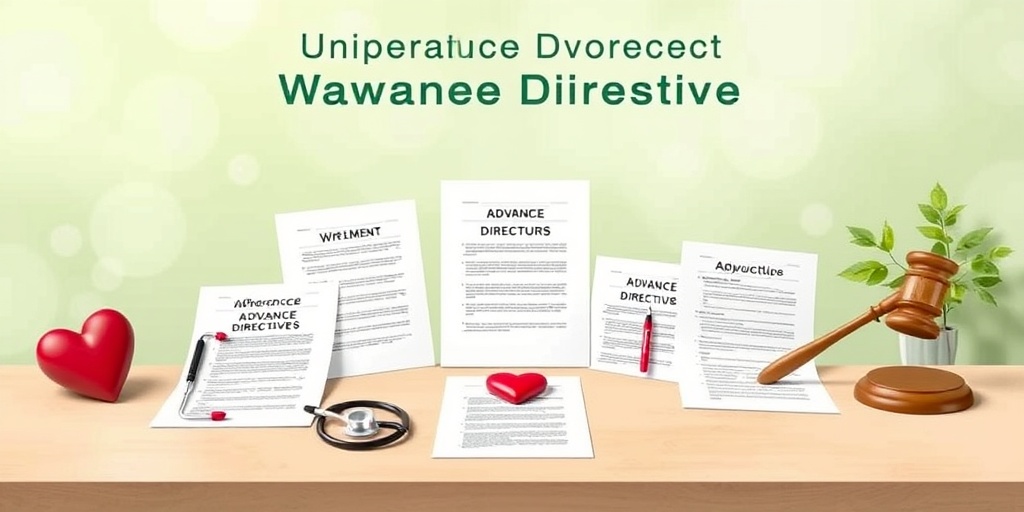What Is an Advance Directive?
An advance directive is a legal document that allows individuals to outline their preferences for medical treatment in the event that they become unable to communicate their wishes. This important tool ensures that your healthcare choices are respected, even when you cannot voice them yourself. Advance directives are particularly crucial for situations involving serious illness, injury, or incapacitation, where decisions about life-sustaining treatments may need to be made quickly.
Advance directives can provide peace of mind, not only for the individual but also for family members and healthcare providers. By clearly stating your preferences, you can alleviate the burden on loved ones who might otherwise have to make difficult decisions on your behalf. It’s a proactive step in managing your healthcare and ensuring that your values and wishes are honored.
Why Should You Consider Writing an Advance Directive?
Writing an advance directive is a personal decision that can have significant implications for your healthcare. Here are a few reasons why you might want to consider creating one:
- Control Over Medical Decisions: You can specify what types of medical treatments you do or do not want.
- Reduce Family Stress: Your loved ones won’t have to guess your wishes during a crisis.
- Clarify Your Values: It allows you to express your values and beliefs regarding end-of-life care.
- Legal Protection: An advance directive is a legally binding document that healthcare providers must follow.
In essence, an advance directive empowers you to take charge of your healthcare decisions, ensuring that your voice is heard even when you cannot speak for yourself. If you’re interested in learning more about how to write an advance healthcare directive, resources like Yesil Health AI can provide valuable guidance.
Types of Advance Directives
There are several types of advance directives, each serving a unique purpose. Understanding these can help you choose the right one for your needs:
1. Living Will
A living will is a document that outlines your preferences for medical treatment in situations where you are terminally ill or permanently unconscious. It specifies which life-sustaining treatments you want or do not want, such as:
- Mechanical ventilation
- Resuscitation (CPR)
- Tube feeding
- Pain management
By detailing your wishes, a living will helps healthcare providers and family members understand your desires regarding end-of-life care.
2. Durable Power of Attorney for Healthcare
A durable power of attorney for healthcare designates a trusted individual to make medical decisions on your behalf if you are unable to do so. This person, often referred to as your healthcare proxy or agent, should be someone who understands your values and wishes. This document is particularly useful in situations where your preferences may not be explicitly stated in a living will.
3. Do Not Resuscitate (DNR) Order
A Do Not Resuscitate (DNR) order is a specific type of advance directive that instructs healthcare providers not to perform CPR if your heart stops or if you stop breathing. This order is typically used in conjunction with other advance directives and is particularly relevant for individuals with terminal illnesses or those who wish to avoid aggressive medical interventions.
4. Physician Orders for Life-Sustaining Treatment (POLST)
The Physician Orders for Life-Sustaining Treatment (POLST) is a medical order that outlines your preferences for treatment in a more detailed manner than a living will. It is designed for individuals with serious health conditions and is signed by both the patient and their physician. POLST forms are recognized across various healthcare settings, ensuring that your wishes are honored wherever you receive care.
5. Advance Care Planning
Advance care planning is a broader process that involves discussing and documenting your healthcare preferences with your loved ones and healthcare providers. This can include creating advance directives, but it also encompasses conversations about your values, beliefs, and goals for care. Engaging in advance care planning can help ensure that your healthcare aligns with your personal wishes.
In conclusion, understanding the different types of advance directives is essential for making informed decisions about your healthcare. Whether you choose to create a living will, designate a healthcare proxy, or complete a POLST form, taking these steps can provide clarity and peace of mind for both you and your loved ones. For more information on how to write an advance healthcare directive, consider visiting Yesil Health AI for expert guidance and resources. 🌟

Why You Need an Advance Directive
When it comes to healthcare decisions, having a plan in place is crucial. An advance directive is a legal document that allows you to outline your preferences for medical treatment in case you become unable to communicate your wishes. Here are some compelling reasons why you should consider writing one:
1. Control Over Your Healthcare Decisions
One of the primary reasons to create an advance directive is to maintain control over your healthcare decisions. This document allows you to specify what types of medical treatments you do or do not want, ensuring that your wishes are respected even when you cannot voice them. Whether it’s opting for life-sustaining treatments or choosing palliative care, having an advance directive empowers you to make those choices ahead of time.
2. Reducing Family Burden
In times of crisis, family members often face difficult decisions regarding a loved one’s care. By having an advance care directive, you can alleviate the emotional burden on your family. They won’t have to guess what you would have wanted, which can lead to conflict and stress. Instead, they can focus on supporting each other during a challenging time.
3. Ensuring Your Values Are Honored
Your values and beliefs play a significant role in your healthcare decisions. An advance directive allows you to express these values clearly. Whether you prioritize quality of life over longevity or have specific religious beliefs regarding medical interventions, documenting these preferences ensures that your healthcare team understands and respects your wishes.
4. Legal Protection
Having an advance directive provides legal protection for your healthcare choices. In many jurisdictions, healthcare providers are required to follow the instructions outlined in your advance directive. This legal backing ensures that your wishes are honored, reducing the risk of unwanted treatments or interventions.
5. Peace of Mind
Knowing that you have a plan in place can provide immense peace of mind. You can rest assured that your healthcare preferences are documented and that your loved ones are aware of your wishes. This sense of security can be incredibly comforting, especially as you age or face health challenges.
How to Write an Advance Directive
Writing an advance directive may seem daunting, but it doesn’t have to be. Here’s a step-by-step guide to help you through the process:
1. Understand the Types of Advance Directives
Before you start writing, it’s essential to understand the different types of advance directives. The two most common are:
- Living Will: This document outlines your preferences for medical treatment in specific situations, such as terminal illness or irreversible coma.
- Durable Power of Attorney for Healthcare: This allows you to designate someone to make healthcare decisions on your behalf if you are unable to do so.
2. Reflect on Your Values and Wishes
Take some time to think about what matters most to you regarding your healthcare. Consider questions like:
- What are your thoughts on life-sustaining treatments?
- How do you define quality of life?
- Are there specific medical interventions you would want or refuse?
Reflecting on these questions will help you articulate your wishes clearly.
3. Use a Template or Sample Advance Directive
To make the process easier, consider using a template or a sample advance directive PDF. Many organizations provide free resources that you can customize to fit your needs. These templates often include sections for both a living will and a durable power of attorney for healthcare.
4. Discuss Your Wishes with Loved Ones
Once you’ve drafted your advance directive, it’s crucial to discuss it with your family and the person you’ve designated as your healthcare proxy. Open communication ensures that everyone understands your wishes and can advocate for you if necessary.
5. Sign and Store Your Document Properly
After finalizing your advance directive, make sure to sign it according to your state’s laws. Some states require witnesses or notarization. Once signed, store the document in a safe but accessible place. Consider providing copies to your healthcare provider, family members, and anyone else involved in your care.
By taking these steps, you can create an advance directive that reflects your values and preferences, ensuring that your healthcare wishes are honored when it matters most. 📝💖

Key Components of an Advance Directive
Writing an advance directive is a crucial step in ensuring that your healthcare preferences are respected when you are unable to communicate them yourself. An advance directive, also known as an advance care directive, outlines your wishes regarding medical treatment and appoints someone to make decisions on your behalf. Here are the key components that should be included in your advance directive:
1. Healthcare Preferences
One of the most important aspects of an advance directive is clearly stating your healthcare preferences. This includes:
- Life-Sustaining Treatments: Specify whether you want to receive treatments such as resuscitation, mechanical ventilation, or feeding tubes.
- Palliative Care: Indicate your wishes regarding pain management and comfort care, especially if you are facing a terminal illness.
- Organ Donation: If you wish to be an organ donor, include this information in your directive.
2. Appointment of a Healthcare Proxy
Choosing a healthcare proxy is a vital part of writing an advance directive. This person will make medical decisions on your behalf if you are unable to do so. Consider the following when selecting your proxy:
- Trustworthiness: Choose someone you trust to honor your wishes and act in your best interest.
- Communication Skills: Your proxy should be able to communicate effectively with healthcare providers and understand your preferences.
- Availability: Ensure that your chosen proxy is willing and able to be available when needed.
3. Specific Instructions
In addition to general healthcare preferences, it’s important to provide specific instructions. This can include:
- Do Not Resuscitate (DNR) Orders: If you do not wish to be resuscitated in the event of cardiac arrest, make this clear.
- Specific Medical Conditions: Outline how you want to be treated for specific conditions, such as dementia or terminal illness.
4. Legal Considerations
To ensure that your advance directive is legally binding, consider the following:
- State Laws: Familiarize yourself with your state’s laws regarding advance directives, as requirements can vary.
- Signature and Witnesses: Most states require your advance directive to be signed and witnessed or notarized.
5. Review and Update Regularly
Your healthcare preferences may change over time, so it’s essential to review and update your advance directive regularly. Major life events, such as a new diagnosis or changes in your family situation, may necessitate updates to your directive.
Choosing a Healthcare Proxy
Choosing a healthcare proxy is one of the most significant decisions you will make when writing an advance directive. This individual will be responsible for making medical decisions on your behalf if you are unable to do so. Here are some important factors to consider when selecting your healthcare proxy:
1. Understanding Your Values and Wishes
Your healthcare proxy should have a clear understanding of your values and wishes regarding medical treatment. It’s essential to have open and honest conversations with them about:
- Your Healthcare Preferences: Discuss your preferences for life-sustaining treatments, palliative care, and any specific medical conditions.
- Your Values: Share what matters most to you in terms of quality of life and end-of-life care.
2. Emotional Resilience
Being a healthcare proxy can be emotionally challenging. Choose someone who can handle the stress of making difficult decisions and who can advocate for your wishes even in tough situations. Look for someone who:
- Can Stay Calm: They should be able to remain composed under pressure.
- Can Communicate Effectively: Your proxy should be able to articulate your wishes to healthcare providers clearly.
3. Willingness to Serve
It’s crucial that your chosen proxy is willing to take on this responsibility. Discuss the role with them beforehand to ensure they are comfortable and prepared to act on your behalf. Consider asking them:
- Are You Comfortable Making Medical Decisions?
- Do You Understand the Responsibilities Involved?
4. Proximity and Availability
Your healthcare proxy should ideally be someone who lives nearby or can be easily reached in case of an emergency. This ensures they can be present when decisions need to be made quickly. Consider:
- Location: Choose someone who is geographically close to you or your healthcare facility.
- Availability: Ensure they have the time and flexibility to be involved in your care.
5. Legal Documentation
Once you have chosen your healthcare proxy, it’s essential to document this decision in your advance directive. Make sure to:
- Include Their Contact Information: Provide their phone number and address for easy access.
- Discuss the Legal Requirements: Ensure that your proxy understands any legal obligations associated with their role.
Choosing a healthcare proxy is a vital step in writing an advance directive. By selecting someone who understands your values and wishes, you can ensure that your healthcare preferences are honored when it matters most. 🏥💖

Legal Considerations
When it comes to writing an advance directive, understanding the legal landscape is crucial. An advance directive is a legal document that outlines your preferences for medical treatment in case you become unable to communicate your wishes. Here are some key legal considerations to keep in mind:
Understanding State Laws
Advance directive laws can vary significantly from state to state. It’s essential to familiarize yourself with the specific regulations in your area. Some states may require witnesses or notarization for the document to be valid, while others may not. To ensure your advance directive is legally binding, consider the following:
- Check your state’s requirements: Research the specific laws governing advance directives in your state.
- Consult a legal professional: If you’re unsure about the legalities, seeking advice from an attorney who specializes in healthcare law can be beneficial.
- Use state-specific forms: Many states provide standardized forms for advance directives, which can simplify the process.
Choosing a Healthcare Proxy
One of the most critical components of an advance directive is appointing a healthcare proxy or agent. This person will make medical decisions on your behalf if you are unable to do so. When selecting a proxy, consider the following:
- Trustworthiness: Choose someone you trust to respect your wishes and make decisions in your best interest.
- Communication: Ensure your proxy understands your values and preferences regarding medical treatment.
- Availability: Consider whether your chosen proxy will be available to make decisions when needed.
Potential Challenges
While advance directives are designed to ensure your wishes are honored, there can be challenges in enforcing them. Some potential issues include:
- Ambiguity: If your advance directive is vague or unclear, healthcare providers may struggle to interpret your wishes.
- Conflicts among family members: Disagreements among family members can arise, especially if they have differing opinions about your care.
- Changes in medical technology: Advances in medical technology may lead to situations not addressed in your directive.
To mitigate these challenges, it’s essential to communicate openly with your family and healthcare providers about your advance directive and your wishes regarding medical treatment. 🗣️
Updating Your Advance Directive
Your health and preferences may change over time, making it important to regularly review and update your advance directive. Here are some tips on how to effectively update your document:
When to Update
Consider updating your advance directive in the following situations:
- Life changes: Major life events such as marriage, divorce, or the birth of a child may prompt a reevaluation of your healthcare preferences.
- Health changes: If you receive a new diagnosis or your health status changes significantly, it may be time to revise your directive.
- Changes in values or beliefs: As you grow and evolve, your views on medical treatment may shift, necessitating an update.
How to Update Your Advance Directive
Updating your advance directive is a straightforward process. Follow these steps:
- Review your current directive: Read through your existing document to identify areas that need revision.
- Consult with your healthcare provider: Discuss any changes in your health or treatment preferences with your doctor.
- Complete a new form: If your state requires it, fill out a new advance directive form and ensure it meets all legal requirements.
- Notify relevant parties: Share your updated directive with your healthcare proxy, family members, and healthcare providers.
Storing Your Advance Directive
Once you’ve updated your advance directive, it’s essential to store it in a safe yet accessible place. Consider the following options:
- Digital storage: Keep a digital copy in a secure cloud storage service, ensuring it’s easily accessible when needed.
- Physical copies: Provide copies to your healthcare proxy, family members, and your primary care physician.
- Emergency contacts: Make sure your advance directive is included in your medical records or with emergency contacts.
By regularly updating your advance directive and ensuring it reflects your current wishes, you can have peace of mind knowing that your healthcare preferences will be honored. 📝

Frequently Asked Questions about Writing an Advance Directive
What is an Advance Directive?
An advance directive is a legal document that allows individuals to outline their preferences for medical treatment in case they become unable to communicate their wishes. This document can include decisions about life-sustaining treatments, organ donation, and other healthcare preferences.
Why Should I Write an Advance Directive?
Writing an advance care directive ensures that your healthcare wishes are known and respected, even if you cannot express them yourself. It can relieve your loved ones from the burden of making difficult decisions during stressful times.
What Should Be Included in an Advance Directive?
An advance directive typically includes:
- Your healthcare preferences regarding life-sustaining treatments.
- Designation of a healthcare proxy or agent to make decisions on your behalf.
- Instructions regarding organ donation.
- Any specific wishes related to your care and treatment.
How Do I Create an Advance Directive?
To create an advance directive, follow these steps:
- Research your state’s laws regarding advance directives.
- Consider your healthcare preferences and discuss them with your family and healthcare provider.
- Use a template or form specific to your state, which can often be found online.
- Sign the document in accordance with your state’s requirements, which may include witnesses or notarization.
Can I Write My Own Advance Directive?
Yes, you can write your own advance directive as long as it meets your state’s legal requirements. However, it is advisable to use a template or consult with a legal professional to ensure that your document is valid and comprehensive.
Where Can I Find a Sample Advance Directive PDF?
You can find a sample advance directive PDF by searching online for templates specific to your state. Many healthcare organizations and legal aid websites provide free resources to help you get started.
What Happens If I Don’t Have an Advance Directive?
If you do not have an advance directive, medical decisions may be made by your family members or healthcare providers based on what they believe is in your best interest. This can lead to confusion and disagreements among loved ones during critical times.
How Can I Ensure My Advance Directive is Followed?
To ensure your advance directive is followed:
- Discuss your wishes with your healthcare provider and family members.
- Keep copies of your directive in accessible places and provide copies to your healthcare proxy and doctors.
- Review and update your directive regularly to reflect any changes in your preferences.
Is an Advance Directive the Same as a Living Will?
While an advance directive and a living will are similar, they are not the same. A living will specifically outlines your wishes regarding medical treatments at the end of life, whereas an advance directive can include broader healthcare decisions and appoint a healthcare proxy.
Can I Change My Advance Directive?
Yes, you can change your advance directive at any time. It is important to update it whenever your preferences change and to inform your healthcare proxy and family members of any updates.
Do I Need a Lawyer to Write an Advance Directive?
While it is not necessary to have a lawyer to write an advance directive, consulting one can help ensure that your document complies with state laws and accurately reflects your wishes.




